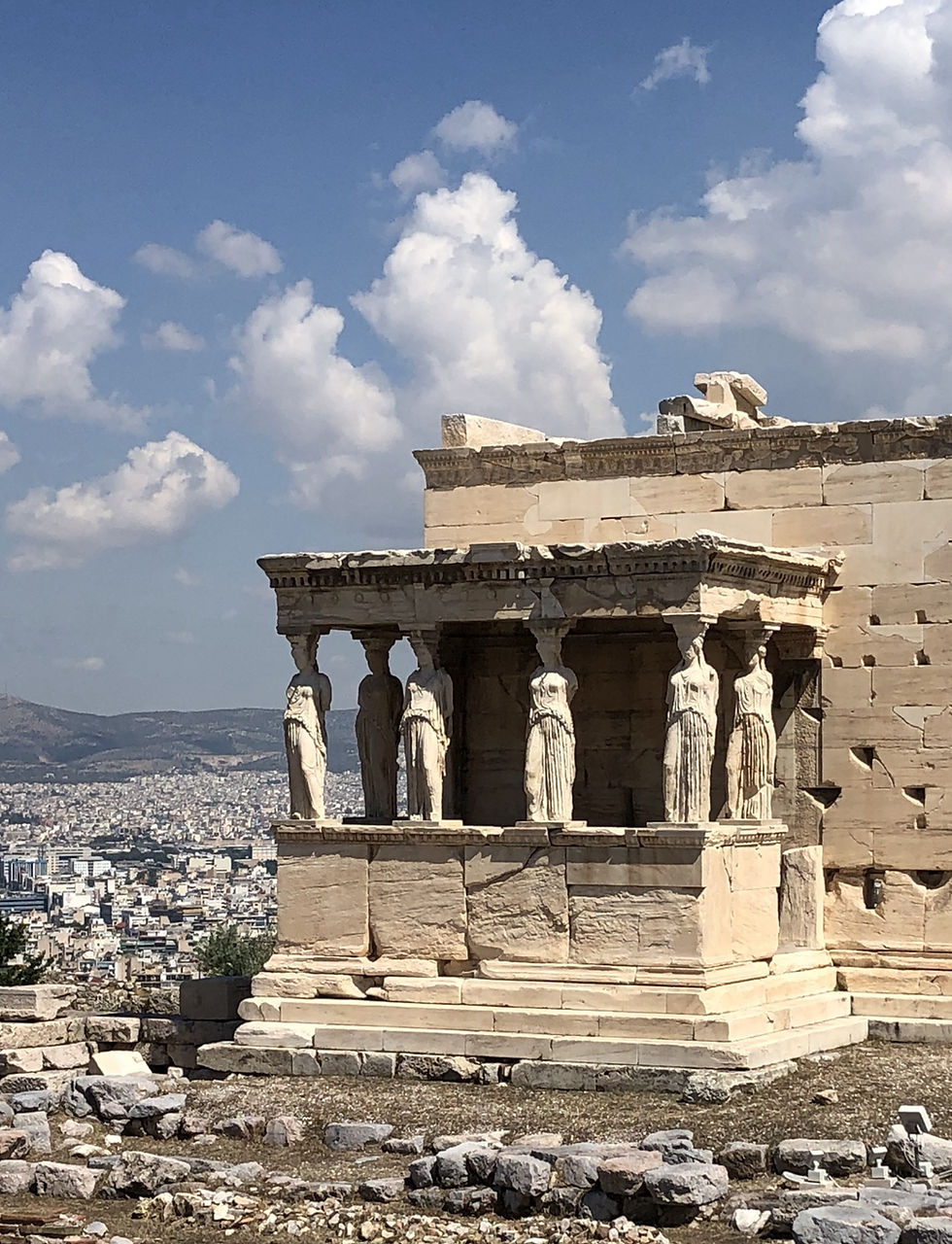Yesterday at 11 am, when visiting the Acropolis, I noticed a refreshing breeze blowing from the sea towards the mountains to the east. Cumulus clouds were building up and within two hours a loud thunderstorm was soaking the town. Gemma, our travel guide, said proudly “The Greek were smart when they built Athens – there was very little water here but every afternoon a thunderstorm”.

Cumulus clouds over the Erechteion on the Acropolis
Looking at the rainfall map of Greece, Athens is indeed built in one of the most arid parts of Greece. Most rainfall occurs in the country’s western part.

The town stands mostly on limestone, the floor of the former Tethys Sea - folded during the last 20 million years. Limestone is a terrific rock to build fortresses like the Acropolis. But it cannot retain water. Luckily it is interceded here with layers of clay preventing the rainwater from completely disappearing underground as it does in Dalmatia. Thus, Athens has three – now mostly invisible rivers – the Kiffisos flowing from the Parnithian Mountains to the North, the eastern Ilissos which passes Athens to the South and the smaller Eridanus which partially crosses ancient Athens.

Topography of Athens - an inverted V-shaped large valley open to air inflow from the sea
These rivers get their water supply from the daily thunderstorms. As the day heats up, the air over Athens begins to rise, pulling in cooler air from the sea. This air is humid, heats up once over the land mass and rises as well. Usually by 11 am, the typical cumulus clouds start to form. The warm, saturated air rises until the colder temperatures higher up force the vapor to condense. Rain drops form in the afternoon, the thunderstorm starts.

The sea breeze cycle during the day - it reverses at night - and reverses again next day
In the evening, once the sun is low on the horizon, the process reverses. The land cools faster than the sea. Air now rises over the warmer sea and cooler, heavier and dry air drops over land from higher altitudes, pushing the humid air that covered Athens during the day out to the sea. The nights are cooler, visibility increases and there will be an immaculate deep blue sky the next morning.

The Ilissos river next to the temple of Zeus end of 19th century - this is now underground
The constant sea breeze was much to Athens’ advantage. It provided the wind for the ships to sail to the harbor of Piraeus, it cooled down Athens during the day and provided the rainwater for Athens’ three rivers. As long as Athens remained small, the land bordering the three rivers provided enough food and the rivers enough water for the citizens’ needs.

The Kiffisos River to the north of the Acropolis - now also disappeared underground
Today is different. The whole valley around Athens disappeared below concrete buildings and streets. The three rivers still flow but mostly underground. The consequences are noticeable. From July to September, Athens does not cool down. Temperature stagnates between 32 and 40 C. The buildings absorb too much heat during the day and Athens’ temperature exceeds the Mediterranean’s temperature at night. Also, there is no cooling effect from the riverbanks anymore.

The Ilissos River in the 1950s just before it was fully covered by massive concrete plates
Saturated air continues to flow into Athens at night. The microclimate remains hot and humid – and is rather unhealthy as the statistics show. With temperatures already high in the morning, more vapor is put into the atmosphere. Violent thunderstorms with terrible flash floods are the result.

Flash flood in Athens in 2013
Athens outgrew its natural habitat probably more than 2’500 years ago. The silver mines at the tip of Attikca allowed the town to import food and wood. By around 500 BC, Athens had 200’000 inhabitants. Only Syracuse, Taranto and Alexandria, towns surrounded by rich, fertile land, could match its size. Athens became the Greek powerhouse we know about today. But it lasted only as long as the silver mines were productive.

Athens in the 5th century BC - the walls protect the vital food supply from Piraeus Harbour
As ancient Athens developed, water became scarce. In addition, the success of Athens’ pottery industry (remember the clay?) required more and more water. Without radical new ideas, the water shortage would have made short shrift of Athens. As always, necessity is the mother of inventions. One of the longest aqueduct was built under the Athens' tyrant Peisistratos (546-527) to bring water from the north-eastern mountains to the town. Later, his aqueduct was complemented by a second, bigger pipeline built under Roman Emperor Hadrian who had a soft spot for Athens. I may write a separate blog about him and Athens.

Hadrian's Aqueduct superimposed on a modern satellite photo from Google Earth
Athens is as short of water today as it was in the past. Given that half of the Greek people (10.8 m) live in Athens, this does not come as a surprise. Science and engineering were and will be the remedies to address the issues of over-heating and water shortage. Giant aqueducts have been built to the Epirus mountains in the west where rainfall is highest in all of Greece and almost reaches English levels (England receives 1'400 mm of rain p.a.).

Giant Aqueducts bring water from mounains 200 km to the west
Careful studies of Athens’ microclimate identified the root causes of the over-heating such as heat absorbing building materials, lack of open spaces and the covering of the three rivers in the 1950 and 1960. One of the most promising projects is the opening of the rivers again. But soon there will be new regulations to improve the light reflection of buildings.

Recent project to open some parts of the Ilissos River close to the Temple of Zeus
Comentarios